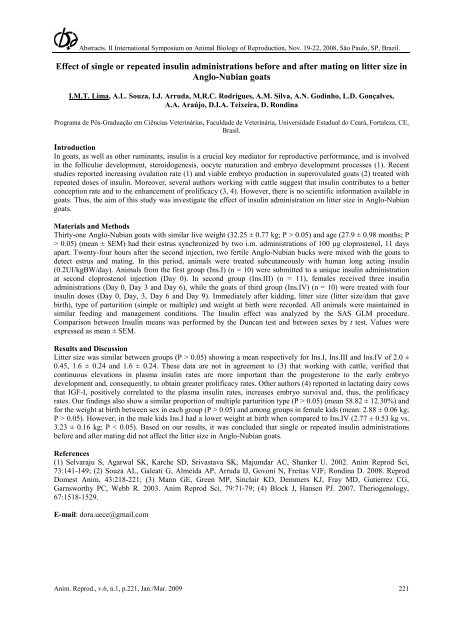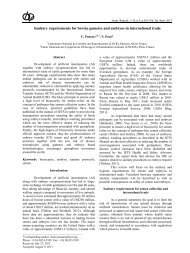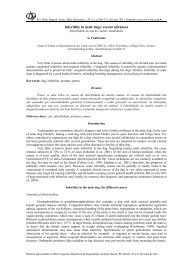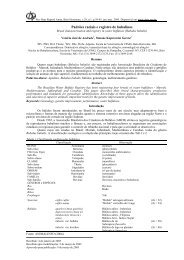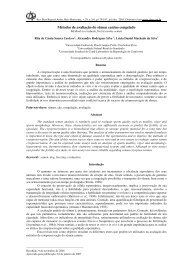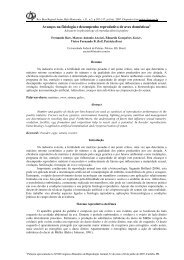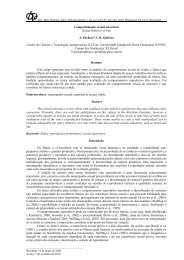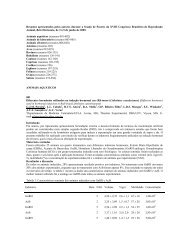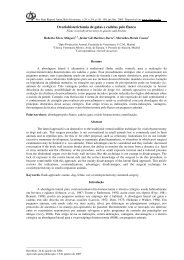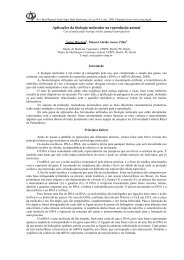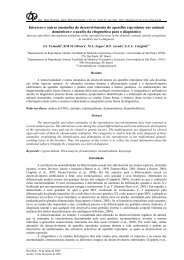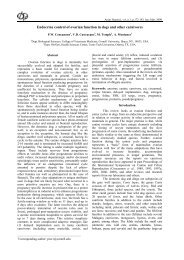Recent advances in ovulation synchronization and superovulation in ...
Recent advances in ovulation synchronization and superovulation in ...
Recent advances in ovulation synchronization and superovulation in ...
Create successful ePaper yourself
Turn your PDF publications into a flip-book with our unique Google optimized e-Paper software.
Abstracts. II International Symposium on Animal Biology of Reproduction, Nov. 19-22, 2008, São Paulo, SP, Brazil.<br />
Effect of s<strong>in</strong>gle or repeated <strong>in</strong>sul<strong>in</strong> adm<strong>in</strong>istrations before <strong>and</strong> after mat<strong>in</strong>g on litter size <strong>in</strong><br />
Anglo-Nubian goats<br />
I.M.T. Lima, A.L. Souza, I.J. Arruda, M.R.C. Rodrigues, A.M. Silva, A.N. God<strong>in</strong>ho, L.D. Gonçalves,<br />
A.A. Araújo, D.I.A. Teixeira, D. Rond<strong>in</strong>a<br />
Programa de Pós-Graduação em Ciências Veter<strong>in</strong>árias, Faculdade de Veter<strong>in</strong>ária, Universidade Estadual do Ceará, Fortaleza, CE,<br />
Brasil.<br />
Introduction<br />
In goats, as well as other rum<strong>in</strong>ants, <strong>in</strong>sul<strong>in</strong> is a crucial key mediator for reproductive performance, <strong>and</strong> is <strong>in</strong>volved<br />
<strong>in</strong> the follicular development, steroidogenesis, oocyte maturation <strong>and</strong> embryo development processes (1). <strong>Recent</strong><br />
studies reported <strong>in</strong>creas<strong>in</strong>g <strong>ovulation</strong> rate (1) <strong>and</strong> viable embryo production <strong>in</strong> superovulated goats (2) treated with<br />
repeated doses of <strong>in</strong>sul<strong>in</strong>. Moreover, several authors work<strong>in</strong>g with cattle suggest that <strong>in</strong>sul<strong>in</strong> contributes to a better<br />
conception rate <strong>and</strong> to the enhancement of prolificacy (3, 4). However, there is no scientific <strong>in</strong>formation available <strong>in</strong><br />
goats. Thus, the aim of this study was <strong>in</strong>vestigate the effect of <strong>in</strong>sul<strong>in</strong> adm<strong>in</strong>istration on litter size <strong>in</strong> Anglo-Nubian<br />
goats.<br />
Materials <strong>and</strong> Methods<br />
Thirty-one Anglo-Nubian goats with similar live weight (32.25 ± 0.77 kg; P > 0.05) <strong>and</strong> age (27.9 ± 0.98 months; P<br />
> 0.05) (mean ± SEM) had their estrus synchronized by two i.m. adm<strong>in</strong>istrations of 100 µg cloprostenol, 11 days<br />
apart. Twenty-four hours after the second <strong>in</strong>jection, two fertile Anglo-Nubian bucks were mixed with the goats to<br />
detect estrus <strong>and</strong> mat<strong>in</strong>g. In this period, animals were treated subcutaneously with human long act<strong>in</strong>g <strong>in</strong>sul<strong>in</strong><br />
(0.2UI/kgBW/day). Animals from the first group (Ins.I) (n = 10) were submitted to a unique <strong>in</strong>sul<strong>in</strong> adm<strong>in</strong>istration<br />
at second cloprostenol <strong>in</strong>jection (Day 0). In second group (Ins.III) (n = 11), females received three <strong>in</strong>sul<strong>in</strong><br />
adm<strong>in</strong>istrations (Day 0, Day 3 <strong>and</strong> Day 6), while the goats of third group (Ins.IV) (n = 10) were treated with four<br />
<strong>in</strong>sul<strong>in</strong> doses (Day 0, Day, 3, Day 6 <strong>and</strong> Day 9). Immediately after kidd<strong>in</strong>g, litter size (litter size/dam that gave<br />
birth), type of parturition (simple or multiple) <strong>and</strong> weight at birth were recorded. All animals were ma<strong>in</strong>ta<strong>in</strong>ed <strong>in</strong><br />
similar feed<strong>in</strong>g <strong>and</strong> management conditions. The Insul<strong>in</strong> effect was analyzed by the SAS GLM procedure.<br />
Comparison between Insul<strong>in</strong> means was performed by the Duncan test <strong>and</strong> between sexes by t test. Values were<br />
expressed as mean ± SEM.<br />
Results <strong>and</strong> Discussion<br />
Litter size was similar between groups (P > 0.05) show<strong>in</strong>g a mean respectively for Ins.I, Ins.III <strong>and</strong> Ins.IV of 2.0 ±<br />
0.45, 1.6 ± 0.24 <strong>and</strong> 1.6 ± 0.24. These data are not <strong>in</strong> agreement to (3) that work<strong>in</strong>g with cattle, verified that<br />
cont<strong>in</strong>uous elevations <strong>in</strong> plasma <strong>in</strong>sul<strong>in</strong> rates are more important than the progesterone to the early embryo<br />
development <strong>and</strong>, consequently, to obta<strong>in</strong> greater prolificacy rates. Other authors (4) reported <strong>in</strong> lactat<strong>in</strong>g dairy cows<br />
that IGF-I, positively correlated to the plasma <strong>in</strong>sul<strong>in</strong> rates, <strong>in</strong>creases embryo survival <strong>and</strong>, thus, the prolificacy<br />
rates. Our f<strong>in</strong>d<strong>in</strong>gs also show a similar proportion of multiple parturition type (P > 0.05) (mean 58.82 ± 12.30%) <strong>and</strong><br />
for the weight at birth between sex <strong>in</strong> each group (P > 0.05) <strong>and</strong> among groups <strong>in</strong> female kids (mean: 2.88 ± 0.06 kg;<br />
P > 0.05). However, <strong>in</strong> the male kids Ins.I had a lower weight at birth when compared to Ins.IV (2.77 ± 0.53 kg vs.<br />
3.23 ± 0.16 kg; P < 0.05). Based on our results, it was concluded that s<strong>in</strong>gle or repeated <strong>in</strong>sul<strong>in</strong> adm<strong>in</strong>istrations<br />
before <strong>and</strong> after mat<strong>in</strong>g did not affect the litter size <strong>in</strong> Anglo-Nubian goats.<br />
References<br />
(1) Selvaraju S, Agarwal SK, Karche SD, Srivastava SK, Majumdar AC, Shanker U. 2002. Anim Reprod Sci,<br />
73:141-149; (2) Souza AL, Galeati G, Almeida AP, Arruda IJ, Govoni N, Freitas VJF; Rond<strong>in</strong>a D. 2008. Reprod<br />
Domest Anim, 43:218-221; (3) Mann GE, Green MP, S<strong>in</strong>clair KD, Demmers KJ, Fray MD, Gutierrez CG,<br />
Garnsworthy PC, Webb R. 2003. Anim Reprod Sci, 79:71-79; (4) Block J, Hansen PJ. 2007. Theriogenology,<br />
67:1518-1529.<br />
E-mail: dora.uece@gmail.com<br />
Anim. Reprod., v.6, n.1, p.221, Jan./Mar. 2009 221


